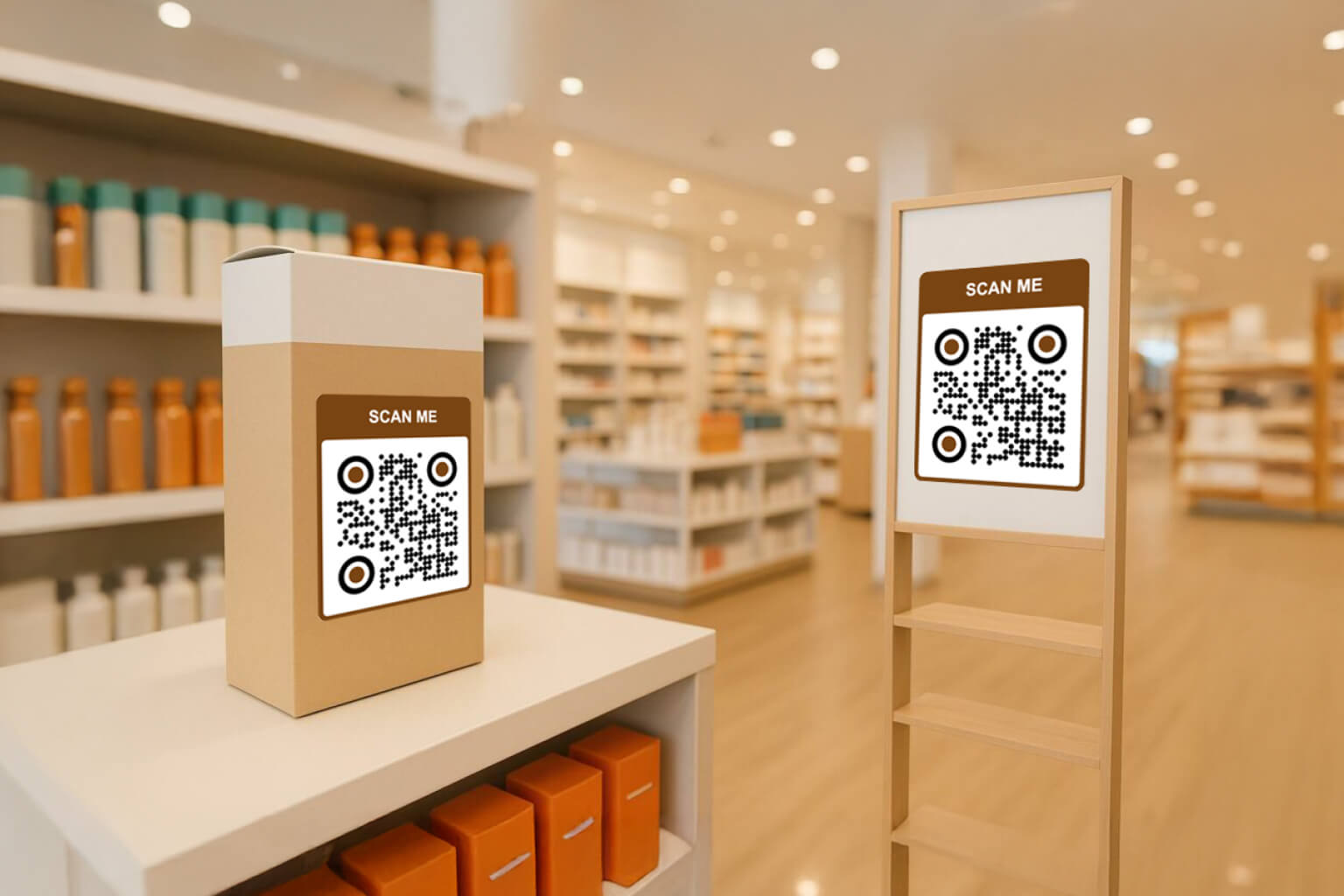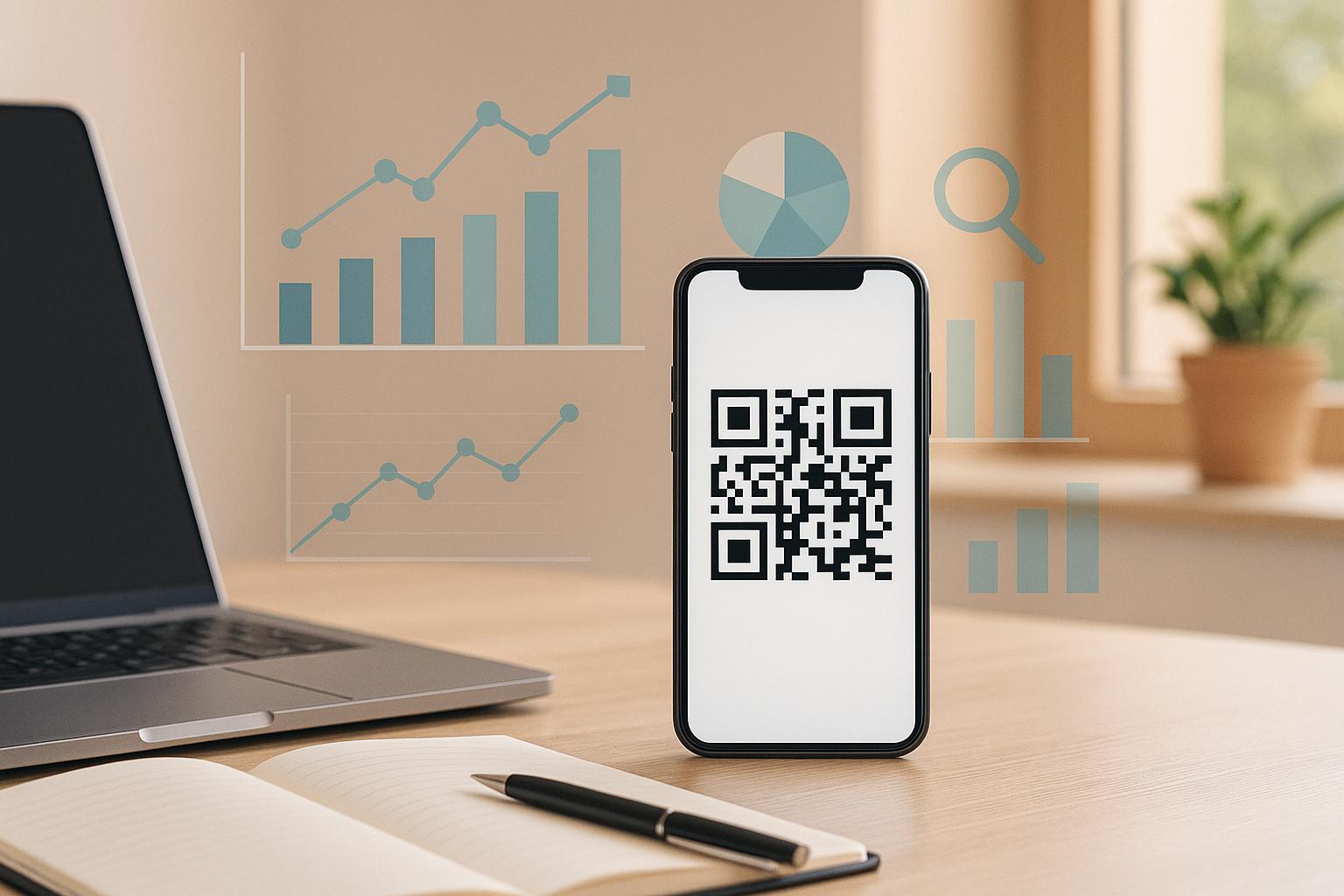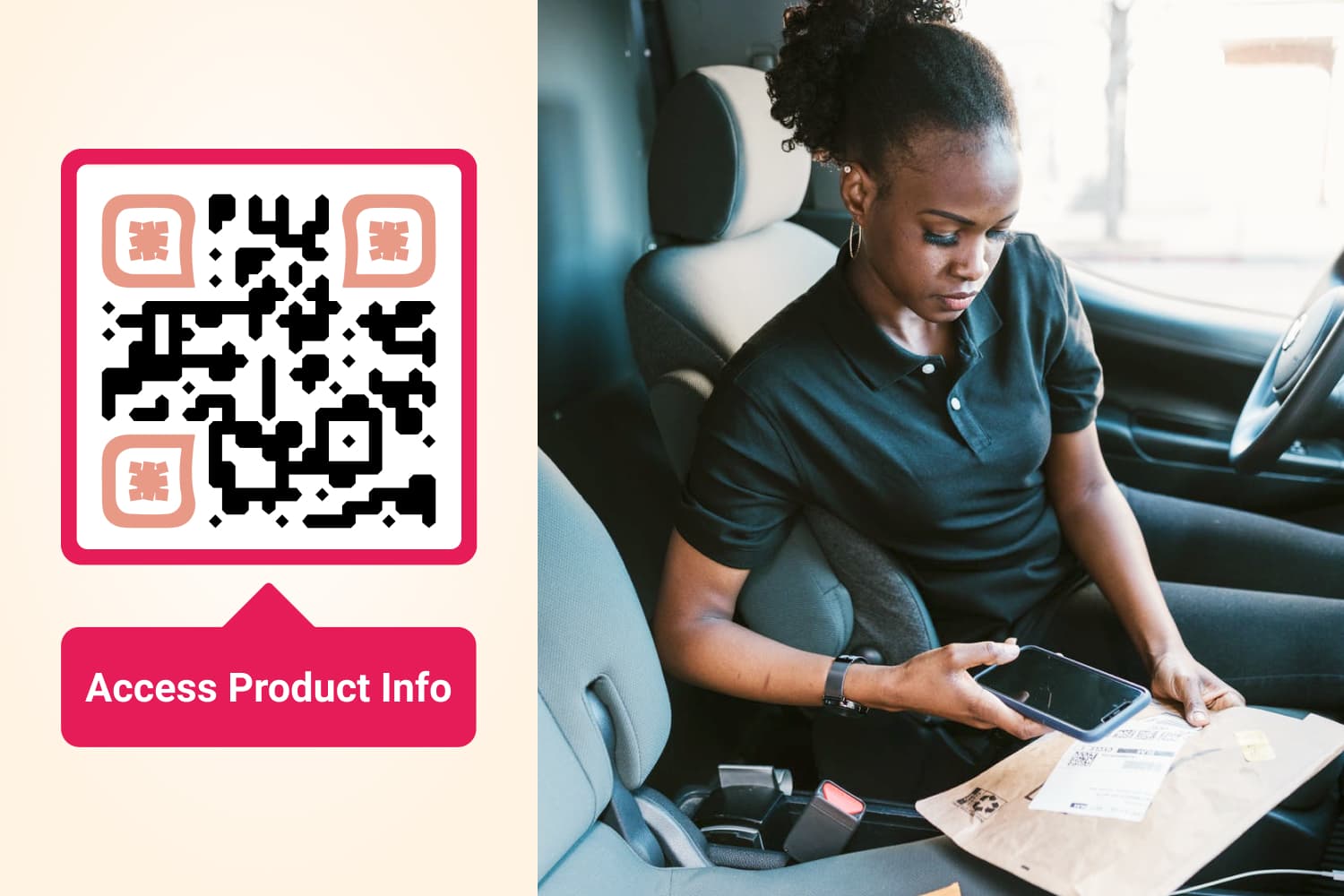QR codes are transforming retail by connecting physical spaces with digital experiences. But where should they go – on packaging or store displays? Here’s the breakdown:
- Packaging QR Codes: Ideal for engaging customers after purchase. They provide product details, sustainability info, loyalty programs, and more. They stay with the product, encouraging repeat use and trust-building.
- Store Display QR Codes: Best for in-store engagement. They drive immediate actions like accessing deals, product comparisons, or app downloads. Positioned strategically, they influence purchase decisions on the spot.
Key Stats:
- 63% of QR scans happen on packaging.
- QR-linked content sees 3–4x higher engagement.
- 90% of consumers scan QR codes weekly.
Quick Tip: Use both strategies for maximum impact – packaging for long-term connection, displays for immediate results.
[Webinar] QR Codes and the Future of Retail – Packaging and 2D Barcodes
Quick Comparison
| Factor | Packaging QR Codes | Store Display QR Codes |
|---|---|---|
| Timing | Post-purchase | Pre-purchase |
| Purpose | Build long-term relationships | Drive immediate actions |
| Environment | Relaxed (home/office) | Busy (in-store) |
| Content Updates | Requires dynamic codes | Supports real-time updates |
| Data Insights | Tracks ongoing customer behavior | Captures in-store actions |
Both options have their strengths. Choose based on your goals – or combine them for a stronger strategy.
QR codes on product packaging
In today’s digital-first world, QR codes on product packaging have become a clever way for brands to keep the conversation going with customers well beyond the checkout counter. Packaging has evolved from being just a protective layer or a branding tool into a dynamic marketing channel. With QR codes, products can act as digital bridges, connecting brands to consumers long after they’ve left the store. Recent data shows that 63% of QR code scans happen on product packaging, making it the second most common place for scans, right after payment apps.
This shift turns traditional packaging into an interactive experience. By scanning these codes, customers can access bonus content that wouldn’t fit on a physical label, creating opportunities for brands to deepen engagement and build stronger relationships with their audience.
Common use cases for QR codes on packaging
Brands are finding inventive ways to integrate QR codes into their packaging strategies, making the experience more engaging and informative for consumers. Here are a few standout examples:
- Nestlé KitKat: The brand added QR codes to their packaging that linked to YouTube playlists, enhancing their famous "break" theme. Andrew McIver, Managing Director at Nestlé, described it as a simple way to provide entertaining content for customers.
- Cocokind: This beauty brand uses QR codes to share detailed information about their "Sustainability Facts", including carbon emissions, ethical labor practices, and recycling tips. Founder Priscilla Tsai explained that this approach shifts the responsibility of education from the consumer to the brand.
- Skittles: As part of their PRIDE campaign, Skittles introduced limited-edition packaging with QR codes leading to augmented reality experiences. These codes allowed customers to explore LGBTQ+ artists’ work and interact with 3D art displays.
Food brands are leveraging QR codes to share nutritional details, recipes, and sourcing information. A survey found that 57% of consumers have scanned food packaging QR codes to learn more about a product, while 68% use them to verify authenticity or check ingredients.
Other popular applications include linking to loyalty programs, product registrations, customer support, and even behind-the-scenes videos showcasing product features. These examples highlight how packaging can become a tool for ongoing engagement, creating a more interactive relationship between brands and consumers.
Benefits of QR codes on packaging
QR codes on packaging offer a range of advantages that go beyond just convenience. For starters, they remain accessible throughout the product’s lifecycle, encouraging repeat engagement and even driving additional purchases. Research shows that 79% of consumers are more likely to buy products with QR codes that provide extra information. This transparency not only influences purchasing decisions but also builds trust.
From a cost perspective, QR codes can significantly reduce printing expenses – by as much as 98% – since brands can replace lengthy manuals or guides with digital versions accessible via a quick scan. Dynamic QR codes take this a step further by allowing real-time updates, which can boost repeat engagement by 3–4 times. Brands can easily update content for seasonal promotions, new product launches, or fresh information without needing to reprint packaging.
Another key advantage is the data QR codes provide. By tracking when, where, and how often codes are scanned, brands can gather valuable insights to refine their marketing strategies and enhance customer engagement.
Drawbacks of QR codes on packaging
Despite their benefits, QR codes on packaging aren’t without challenges. One of the biggest hurdles is space. Packaging designers often struggle to balance the visibility of QR codes with branding aesthetics and regulatory requirements. On smaller packages, there may not be enough room for a properly sized, scannable code.
Consumer behavior also plays a role. While QR code usage has grown, not everyone is eager to scan them. Some consumers worry about data usage if they’re shopping without Wi-Fi, while others may not immediately understand the purpose of the code.
Technical issues can further complicate things. Scanning requires an internet connection, and if the code is poorly printed, damaged, or in low light, it might not work. Static QR codes, in particular, lack the flexibility of dynamic ones, which can adapt and update over time.
Security concerns are another challenge. Malicious actors can create fake QR codes to distribute malware or phishing links, making some consumers hesitant to scan. This has led many brands to adopt dynamic QR codes, which offer more control and security.
Ultimately, the biggest challenge is convincing consumers to scan. Without a clear benefit or an enticing call-to-action, even the best-designed QR codes risk being overlooked. Brands need to ensure that their QR codes offer real value to encourage consistent use.
QR codes on store displays
While QR codes on packaging follow customers home, those on store displays transform static retail spaces into dynamic, interactive experiences. These codes engage shoppers right at the moment they’re deciding what to buy. It’s no wonder the retail industry has embraced this approach, with QR code usage growing by 88% year-over-year in 2023.
Store displays bring something unique to the table. Unlike packaging, they can be larger, more eye-catching, and strategically placed to grab attention at critical points in the shopping journey. As The Global Display Solution™ puts it:
Retailers seek new ways to connect with customers in an increasingly digital world. QR codes on signs bridge the gap between physical stores and digital experiences.
Let’s dive into where these codes work best and how they can be used effectively.
Common placements for QR codes in stores
Smart retailers know that the right placement is everything. QR codes are most effective when positioned in high-traffic areas where shoppers naturally pause or look for more information.
- End caps and promotional displays: These spots, located at the ends of aisles, naturally catch the eye. QR codes here can link to special deals or detailed product information.
- Shelf talkers and product displays: Positioned near specific items, these codes can connect customers to reviews, comparison charts, or demo videos – helpful for complex or high-investment purchases.
- Demo stations and interactive areas: For instance, Rad Power Bikes uses QR codes to turn retail signage into digital touchpoints, helping customers make informed decisions while building trust.
- Checkout counters and waiting areas: These are perfect for engaging customers during downtime, whether it’s encouraging loyalty program signups or sharing exclusive mobile offers.
- Window displays and storefront signage: Even after hours, QR codes here can keep the engagement going by linking to store details, promotions, or upcoming events.
Benefits of QR codes on store displays
QR codes on store displays have a knack for reaching customers at just the right time – when they’re considering a purchase. By scanning a code, shoppers gain instant access to product details, reviews, and comparisons, helping them make confident decisions.
Dynamic QR codes also offer flexibility. Stores can update promotions, inventory details, or seasonal content in real time without reprinting materials. This is especially handy during busy shopping seasons or when stock is constantly changing.
The numbers back up their effectiveness. QR-linked content generates 3-4x higher engagement rates, and 90% of consumers scan QR codes weekly. Additionally, 95% of businesses report using QR codes to gather valuable first-party data, and 62% of businesses expect increased sales by 2025 thanks to QR-driven links, which boast a 37% click-through rate.
These codes also connect offline shoppers to online spaces, linking to social media platforms like Instagram or Facebook, as well as user-generated content. They even provide self-service options, simplifying the shopping experience.
Drawbacks of QR codes on store displays
Despite their advantages, QR codes on store displays come with a few challenges.
Scanning issues are a common problem. Poor lighting or awkward placement can make it hard for shoppers to scan a code, unlike packaging QR codes, which customers can adjust for better visibility.
Placement and size matter. If a code is too high, too low, or too small, it can frustrate shoppers. Industry guidelines suggest QR codes should be at least two inches by two inches for reliable scanning.
Limited engagement windows are another drawback. Unlike packaging codes that can be scanned anytime, display QR codes only work while customers are in the store, reducing opportunities for repeated interaction.
Security risks in public spaces are also a concern. Chester Wisniewski, Director and Global Field Chief Technology Officer at Sophos, warns:
Retail locations using QR codes should regularly inspect them when they are in public places to spot any malfeasance.
Malicious actors can replace legitimate QR codes with fake ones, potentially leading customers to harmful websites.
Technical hiccups can also derail the experience. Poor in-store Wi-Fi, slow internet speeds, or mobile-unfriendly landing pages can turn a promising interaction into a frustrating one. Auto-playing media triggered by QR scans can disrupt the shopping environment as well.
Finally, maintenance is crucial. Store displays need regular checks to ensure QR codes remain scannable, undamaged, and linked to up-to-date content. Staff training is equally important to help with customer questions and troubleshooting.
As Bellamy Grindl, Principal and Founder of Retailytics, points out:
When done well, QR codes can streamline the shopping experience, providing immediate access to product specs, reviews or promotions.
sbb-itb-74874c9
Packaging vs. Store Displays: Direct Comparison
Understanding the difference between QR codes on packaging and store displays boils down to when and how they engage consumers. Packaging QR codes are perfect for fostering ongoing relationships, while store display QR codes shine when driving immediate purchasing decisions. These differences influence how each performs across various metrics. Here’s a quick breakdown:
Comparison Table
| Factor | QR Codes on Packaging | QR Codes on Store Displays |
|---|---|---|
| Engagement Timing | Post-purchase, nurturing long-term connections | Pre-purchase, influencing instant decisions |
| Content Updates | Requires dynamic QR codes for adaptability | Supports real-time updates with dynamic codes |
| Scanning Environment | Typically scanned in relaxed settings like home or office | Often scanned in busy, distraction-prone store environments |
| Brand Control | Stronger control since the code stays with the product, reinforcing brand identity | Relies on store upkeep and display quality |
| Data Collection | Tracks ongoing customer behavior and loyalty | Captures immediate, point-of-sale consumer actions |
| Engagement Duration | Encourages longer, deeper post-purchase interactions | Focuses on short, decision-driven engagements |
| Reach Potential | Targets customers who already own the product | Reaches all store visitors, including casual shoppers |
This breakdown can help you decide which strategy aligns best with your campaign goals and the customer journey stage.
When to Use Packaging, Store Displays, or Both
You don’t always have to choose between packaging and store displays – many brands combine both for maximum impact. QR-linked content generates 3–4x higher engagement rates compared to traditional methods, and 95% of businesses report that QR codes are essential for collecting first-party data.
Opt for packaging QR codes when:
- Your goal is to build lasting relationships and extend engagement beyond the initial purchase.
- Your product benefits from ongoing support, like Hello Tempayy’s recipe videos that inspire confidence and creativity in the kitchen.
- Detailed product information is a priority, such as Hershey’s SmartLabel QR codes that provide ingredient details and allergen warnings.
- Transparency and trust are key, as seen with Whole Truth Foods linking to lab reports to assure authenticity.
Use store display QR codes when:
- You need to grab attention for time-sensitive promotions.
- You want to engage browsers who haven’t yet decided to buy.
- Driving immediate actions, like app downloads or loyalty signups, is your main goal.
Combine both strategies when:
- Consistent messaging across multiple touchpoints is critical.
- Your customer journey benefits from both pre-purchase education and post-purchase support.
- You want to collect data throughout the entire shopping experience.
Take Coca-Cola as an example. They use dynamic QR codes to deliver fresh, rotating content with every scan – creating an interactive experience that works both in-store and at home. This approach is especially effective, considering 90% of consumers scan QR codes weekly, and 59% engage with them daily.
Whether you focus on packaging, store displays, or both, make sure you have the right tools to create a QR code and track its performance seamlessly.
Advanced QR Code Strategies
Building on earlier discussions about the effectiveness of packaging and store displays, advanced QR code strategies take customer engagement to the next level. These strategies transform QR codes from simple tools into powerful marketing assets that drive both immediate action and long-term connections.
Benefits of Dynamic QR Codes
Dynamic QR codes are a step up from their static counterparts. Unlike static codes, which are tied to fixed content, dynamic QR codes allow you to update linked information in real time without needing to replace the physical code. This flexibility is perfect for campaigns that require frequent updates to messaging or promotions.
Dynamic QR codes saw a staggering 41.77 million scans in 2025 – a 433% increase over four years. They not only allow for on-the-go adjustments but also provide valuable analytics, such as scan location, device type, and time of interaction. These insights can help businesses fine-tune their QR code placement and overall strategy.
Customization and Branding
The look of a QR code plays a huge role in whether or not someone decides to scan it. Customization allows you to make your QR codes visually appealing while maintaining alignment with your brand. Branded QR codes – featuring custom colors, logos, and unique designs – help build trust and recognition, making them far more engaging than generic black-and-white codes.
For example, you can incorporate your brand’s colors, add a logo, and choose from various frame styles to make your codes stand out. Packaging codes might have a subtle, elegant design to match the product’s aesthetic, while store display codes could use bold designs to grab attention in a busy environment. The key is to ensure the code remains easy to scan by maintaining proper contrast, size, and logo placement.
Analytics and Marketing Integrations
Advanced analytics take the guesswork out of QR code campaigns. By comparing performance data from QR codes on packaging versus store displays, businesses can learn which approach drives more engagement and conversions. Metrics like total scans, unique users, geographic trends, device types, and time-based patterns offer a clear picture of customer behavior, helping refine future strategies.
Real-time analytics also integrate seamlessly with marketing tools, making it easier to track performance and connect QR code data to broader campaigns. The use of QR codes in marketing and advertising grew by 323%, demonstrating their effectiveness. For instance, PatientPoint, a healthcare marketing company, used QR codes across 2,300 locations post-COVID, resulting in 270,000 total scans and over 208,000 engaged visitors.
"The analytics on Uniqode has been super easy to use and organize. Because of the campaign label function, it became effortless for us to go in and look for specific campaigns. Once the campaigns are sorted, we can begin seeing all the metrics tied into them." – Kinsey Akins, Programmatic Channel Manager, BBQ Guys
Security and Product Authenticity
QR codes can also help verify product authenticity and protect customer data. With 80% of U.S. users expressing trust in QR codes, maintaining robust security is vital. This includes using secure hosting, encrypted data transmission, and clear privacy policies. For store displays, regular monitoring can ensure customers are directed to legitimate destinations, reducing the risk of tampering. These measures not only safeguard user trust but also simplify QR code management.
Tools for Creating and Managing QR Codes
Platforms like Pageloot make it easy to create, customize, and manage QR codes for packaging and store displays. They offer options like PDF QR codes and video QR codes, allowing you to tailor the type of code to your campaign’s goals – whether it’s encouraging app downloads at a store or providing detailed product information on packaging.
Customization tools let you add branded colors, logos, and professional templates, ensuring your QR codes are both visually appealing and fully functional. The ability to create a QR code that aligns with your brand identity is key to driving engagement.
For businesses juggling multiple campaigns, centralized management tools simplify operations. From a single dashboard, you can update content, track performance, and adjust strategies, making it easier to scale your campaigns while maintaining a cohesive brand experience.
Conclusion
Deciding between placing QR codes on packaging or store displays isn’t about picking one over the other – it’s about tailoring your approach to match your business goals and your customers’ journey. Both placements serve different purposes and offer distinct advantages, making it essential to align them with your overall strategy.
QR codes on packaging are perfect for sharing detailed product information, verifying authenticity, and building lasting relationships with customers. They encourage brand loyalty and keep the conversation going after purchase. On the other hand, QR codes on store displays are designed for immediate action, like driving social media engagement or influencing decisions right at the point of sale.
Recent data highlights the impact of QR codes: 90% of consumers scan them weekly, 59% interact with them daily, and 87% use smartphones to research products while shopping in-store. These numbers prove that both packaging and display placements can deliver value. By tracking performance, you can determine which placement resonates most with your audience and drives better results.
Tools like Pageloot take QR codes to the next level with features like real-time updates, detailed analytics, and customization options to match your brand. A well-designed, functional QR code can significantly boost engagement, whether it’s on packaging or a store display. Using these dynamic tools ensures your QR codes not only look great but also deliver the kind of interaction that translates into meaningful results. Want to get started? Create a QR code that aligns perfectly with your brand and goals.
FAQs
How can brands use QR codes on packaging and store displays together for better marketing results?
Brands can elevate their marketing efforts by integrating QR codes into product packaging and store displays in smart, strategic ways. For example, packaging QR codes are perfect for sharing in-depth product details, how-to guides, or exclusive post-purchase perks. Meanwhile, store display QR codes shine when it comes to sparking instant engagement, like promoting flash sales or facilitating event check-ins.
To keep campaigns fresh and relevant, opt for dynamic QR codes. These allow you to update the linked content in real time without needing to reprint materials – saving both time and resources. Plus, tracking scan data can offer valuable insights into customer behavior, helping you fine-tune your strategy for even stronger results. Platforms like Pageloot simplify this process by letting you design, customize, and monitor QR codes. With features like branded visuals and detailed analytics, they make it easy to create a seamless and effective marketing experience.
What security measures should brands take to protect QR codes on store displays?
To keep QR codes on store displays safe, brands need to focus on security and careful monitoring. Start by choosing a reliable QR code generator. This allows you to create secure, dynamic QR codes that can be updated as needed, eliminating the need to reprint them and reducing the chance of outdated or risky links.
Place QR codes in areas where they can be easily monitored to prevent tampering or unauthorized changes. Avoid putting them in spots that are difficult to supervise or vulnerable to interference. It’s also a good idea to routinely check the displayed QR codes to ensure they haven’t been swapped out for fraudulent ones.
Lastly, encourage customers to use trusted apps for scanning QR codes. These apps often come with built-in security features to identify potential threats. Taking these precautions can help protect against issues like phishing, malware, or data theft, creating a safer experience for everyone involved.
What makes dynamic QR codes more effective than static ones, and how can they be used effectively?
Dynamic QR codes offer a clear edge over static ones because they can be updated in real-time, support customizable content, and provide detailed analytics. Unlike their static counterparts, which are permanently fixed, dynamic QR codes allow you to modify their linked content anytime – without the hassle of reprinting. This flexibility makes them perfect for campaigns that demand frequent updates or adjustments.
To make the most of dynamic QR codes, focus on creating personalized user experiences. For instance, you can link them to tailored landing pages or exclusive offers that resonate with your audience. Keep the linked content fresh and engaging by updating it regularly. Additionally, use the analytics these codes provide – like scan location, time, and device type – to refine your marketing strategies and gain deeper insights into your audience’s behavior. When used thoughtfully, dynamic QR codes can help businesses run more engaging campaigns, strengthen customer connections, and adapt swiftly to evolving demands.

























